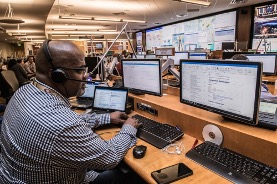Roz Bekker longform article
Creating an era of well-care, where sickness is prevented and wellness maintained, does not just mean preventing individual illness or supporting healthy lifestyles. We must also identify and prevent outbreaks of disease, including pandemics, before they can spread across the globe.
This ideal is only achievable if we can spot outbreaks before or as they are happening in real-time. In the case of many diseases, current surveillance methods are outdated – and while they remain so, we can never move towards a true well-care system.
Current disease surveillance practices
Surveying public health is one of the best ways to detect outbreaks early and contain them.[1] Currently, the continuous collection of data on emerging diseases is handled in hospitals and research centres. As more and more people with certain symptoms are diagnosed, hospitals flag the disease to their internal databases, which pass on that information to health centres, such as the World Health Organization collaborating centres. They then assess the disease risk, selecting viruses for vaccine development and act as a basis for resource allocation decisions.[2][3]

These traditional methods of surveillance involve significant effort and co-ordination, and historically have done an incredible job saving lives and reducing the spread of disease. But they are also reactive methods. By the time we have gathered enough information about a disease to classify and understand it, it can be too late. Despite our best efforts, we are trailing behind the curve. [4]
On top of the delays this system causes, it is also rife with error: data can go missing, over-reporting symptoms or disease cases can occur, and the generalised approach to certain symptoms, for example fever and influenza-like illness, means data collection is unspecific and ultimately less useful.[5]
This is compounded by the disparity many countries face in implementing disease surveillance methods. Poor communication, inadequate financial resources and a lack of trained health workers can all harm the effectiveness of disease surveillance and create a disparate state in which certain countries and populations are exposed to illness and contagion more than others.[6]
Innovative and digital solutions
In my work at Janssen, it is clear that more rapid and specific methods of disease surveillance are needed to better reduce the impact of future outbreaks.[7] Increasingly, scientists are turning to real-time digital methods of surveillance.[8]
Mobile technology and the internet provide us with the opportunity to access vast swathes of data that we can use for real-time, proactive surveillance of the spread of disease.[9][10] With more than 60% of initial disease outbreak reports stemming from informal sources - such as social media or simply browser searches for a disease - online data can reveal to us exactly where and how quickly a disease is spreading.[11][12]

A good example of this innovation is the use of Google search data and query terms to understand flu activity at national levels.[13] Aligning with the CDC’s traditional sources of surveillance data, Google was able to analyse searches for influenza on its platform. Doing this revealed a strong correlation between those searches and where the flu had spiked in that season.
Beyond that, increasing use of geospatial data could also improve how we monitor disease. Geospatial data encompasses transport network information, land use, wind speed, population density and road networks to provide a holistic approach to understanding disease transmission in certain areas. Combining this data with powerful AI analysis software, can help us determine how far and how intensely certain diseases can travel.[14][15]
Of course, implementation of modern technologies alone is only so useful. To ensure that disease surveillance is completely optimised, we must ensure that both staff training and communication practices are up-to-date and efficient. Without them, these methods will remain ineffectual.[16]
As challenging a task as it is, we must change how we react to disease outbreaks, and quickly. Predicting and possibly even preventing future outbreaks does not just reduce the risk of another pandemic: it could save tens of thousands of lives. Without better responses to significant health challenges such as these, we cannot create a system in which wellness is maintained.
Implications of innovation
As with any new technology, innovations in disease surveillance come with challenges. Foremost of these is data security: with more data gathered than ever before, on devices including mobile phones, it is difficult to build user trust that data is entirely safe and secure. Ensuring anonymity and appropriate aggregation of data to safeguard privacy is critical to integrating these new technologies, and there must be an ongoing process to balance this against the benefits of identifying targets for disease intervention.[17]
AI and digital technologies will always have challenges, but if we can cultivate a collective approach to innovation - in which we are all in it together, to transform the future of healthcare for all of us - we can make the most of this opportunity. When people understand how this can work for them, and for everyone, I believe we will see greater uptake of these new technologies, and ultimately greater protection of our health and a reduction in widespread outbreaks of disease.
The past few years have shown us how a pandemic can totally change the way we live our lives and society as a whole. But with faster, more innovative responses to such crises in the future, we will go a long way to minimise the impact of future pandemics. Improving disease innovation will be a big step towards the well-care era of tomorrow: but it is also something that we cannot do without today.
References
[1] Njeru, I, Kareko, D, Kisangau, N et al. Use of technology for public health surveillance reporting: opportunities, challenges and lessons learnt from Kenya. BMC Public Health 2020;20:1101;
[2] Buckee CO, Cardenas MIE, Corpuz J, et al. Productive disruption: opportunities and challenges for innovation in infectious disease surveillance. BMJ Global Health 2018;3:e000538;
[3] WHO: Surveillance in emergencies. Available at: https://www.who.int/emergencies/surveillance [Last accessed: July 2022];
[4] Yang, S., Ning, S. & Kou, S.C. Use Internet search data to accurately track state level influenza epidemics. Sci Rep 2021;11:4023;
[5] Buckee CO, Cardenas MIE, Corpuz J, et al. Productive disruption: opportunities and challenges for innovation in infectious disease surveillance. BMJ Global Health 2018;3:e000538;
[6] Njeru, I, Kareko, D, Kisangau, N et al. Use of technology for public health surveillance reporting: opportunities, challenges and lessons learnt from Kenya. BMC Public Health 2020;20:1101;
[7] Ginsberg, J., Mohebbi, M., Patel, R. et al. Detecting influenza epidemics using search engine query data. Nature 2009;457:1012–1014
[8] Bhatia, S, et al. Using digital surveillance tools for near real-time mapping of the risk of infectious disease spread. npj Digit. Med. 4, 73 (2021). https://doi.org/10.1038/s41746-021-00442-3
[9] Buckee CO, Cardenas MIE, Corpuz J, et al. Productive disruption: opportunities and challenges for innovation in infectious disease surveillance. BMJ Global Health 2018;3:e000538;
[10] Bhatia, S, et al. Using digital surveillance tools for near real-time mapping of the risk of infectious disease spread. npj Digit. Med. 4, 73 (2021). https://doi.org/10.1038/s41746-021-00442-3
[11] Tarkoma S, Alghnam S, Howell MD. Fighting pandemics with digital epidemiology. eClinicalMedicine 2020;26:100512;
[12] Jan, C. Disease surveillance will benefit from mobile technology, but digital solutions must be integrated in health systems. 2022. GSMA. Available at: https://www.gsma.com/mobilefordevelopment/blog/disease-surveillance-will... . Last accessed 24/11/22.
[13] Yang, S., Ning, S. & Kou, S.C. Use Internet search data to accurately track state level influenza epidemics. Sci Rep 2021; 11:4023;
[14] Buckee CO, Cardenas MIE, Corpuz J, et al. Productive disruption: opportunities and challenges for innovation in infectious disease surveillance. BMJ Global Health 2018;3:e000538;
[15] Atek, S., et al. A Geospatial Artificial Intelligence and satellite-based earth observation cognitive system in response to COVID-19. 2022. Acta astronautica, 197, 323–335. https://doi.org/10.1016/j.actaastro.2022.05.013
[16] Buckee CO, Cardenas MIE, Corpuz J, et al. Productive disruption: opportunities and challenges for innovation in infectious disease surveillance. BMJ Global Health 2018;3:e000538;
[17] Buckee CO, Cardenas MIE, Corpuz J, et al. Productive disruption: opportunities and challenges for innovation in infectious disease surveillance. BMJ Global Health 2018;3:e000538;


